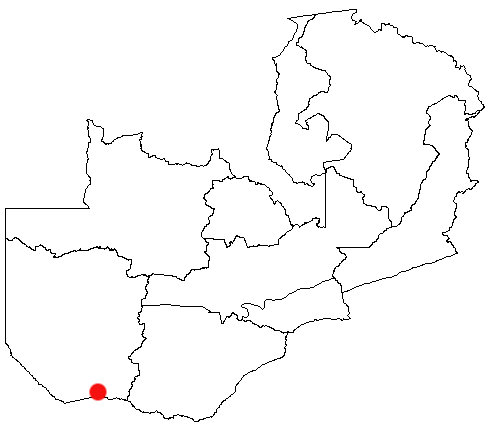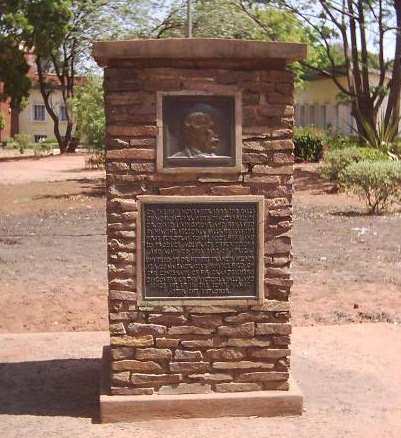|
Senanga
Senanga is the capital of the Senanga District, which is located in the Western Province, Zambia, Western Province of Zambia. The town is situated on the eastern bank of the Zambezi River, at the southern end of the Barotse Floodplain. It lies on the main road running parallel to the river from Livingstone, Zambia, Livingstone and Sesheke to Mongu. Recently the Kaunga Lyeti Bridge was completed to cross the Kaunga Lyeti River near the junction to Sioma, traveling from Sesheke and Katima Mulilo. On top of the bridgework, recent road projects (the roads to Mongu and Sesheke) have improved travel conditions and inspired economic confidence and growth. In addition to the river and floodplain with its wildlife and fishing opportunities, Senanga is about 120 km (75 mi) from Sioma Ngwezi National Park and about 80 km (50 mi) from Ngonye Falls. It has a hotel and serves as a base for fishing tours by boat. A tall radio mast makes a prominent landmark in the town. Senan ... [...More Info...] [...Related Items...] OR: [Wikipedia] [Google] [Baidu] |
Senanga District
Senanga District is a Districts of Zambia, district of Zambia, located in Western Province, Zambia, Western Province. The capital lies at Senanga. As of the 2022 Zambian Census, the district had a population of 112,040 people.2022 Census of Population and Housing - Preliminary Report (PDF) References Districts of Western Province, Zambia {{Zambia-geo-stub ...[...More Info...] [...Related Items...] OR: [Wikipedia] [Google] [Baidu] |
Western Province, Zambia
Western Province is one of the 10 provinces in Zambia and encompasses most of the area formerly known as Barotseland. The capital is Mongu, and together with the neighbouring town of Limulunga, Mongu is treated as the capital of Barotseland. Geography The geography of the province is dominated by the Barotse Floodplain of the Zambezi river, extending from the confluence of the Zambezi with the Lungwebungu and Kabompo Rivers at the northern border of the province, to a point below Senanga and above the Ngonye Falls in the south. This floodplain is inundated from December to June, and is fed by other rivers with their own floodplains, and serves as a vast reservoir storing the waters of the Zambezi. The seasonal flooding is very important to agriculture in the province, providing natural irrigation for the grasslands on which huge herds of cattle depend, and bringing water to the settlements along the edges of the plain. Away from the Zambezi and its tributaries, much o ... [...More Info...] [...Related Items...] OR: [Wikipedia] [Google] [Baidu] |
Zambezi River
The Zambezi (also spelled Zambeze and Zambesi) is the fourth-longest river in Africa, the longest east-flowing river in Africa and the largest flowing into the Indian Ocean from Africa. Its drainage basin covers , slightly less than half of the Nile's. The river rises in Zambia and flows through eastern Angola, along the north-eastern border of Namibia and the northern border of Botswana, then along the border between Zambia and Zimbabwe to Mozambique, where it crosses the country to empty into the Indian Ocean. The Zambezi's most noted feature is Victoria Falls. Its other falls include the Chavuma Falls at the border between Zambia and Angola and Ngonye Falls near Sioma in western Zambia. The two main sources of hydroelectric power on the river are the Kariba Dam, which provides power to Zambia and Zimbabwe, and the Cahora Bassa Dam in Mozambique, which provides power to Mozambique and South Africa. Additionally, two smaller power stations are along the Zambezi River i ... [...More Info...] [...Related Items...] OR: [Wikipedia] [Google] [Baidu] |
Barotse Floodplain
The Barotse Floodplain, also known as the Bulozi Plain, Lyondo or the Zambezi Floodplain, is one of Africa's great wetlands, on the Zambezi River in the Western Province of Zambia. It is a designated Ramsar site, regarded as being of high conservation value. The name recognises the floodplain as spawning the culture and way of life of the Lozi people, "Rotse" being a variant of ''Lozi'', and "Ba" meaning "people". They became a powerful kingdom in Central/Southern Africa under their king or litunga Lewanika, whose realm extended up to 300 km from the plain and was called Barotseland. Topography and area The region is a flat plateau at an elevation of about 1000 m, tilting very slightly to the south. The Zambezi and its headwaters rise on the higher ground to the north, which enjoys good rainfall (1400 mm annually) in a rainy season from October to May. A flood moves down the river, reaching a flat region formed from Kalahari sands, about five hundred kilometres ... [...More Info...] [...Related Items...] OR: [Wikipedia] [Google] [Baidu] |
List Of Populated Places In Zambia
This is a list of cities, towns, villages and Mission (station), missions in Zambia. Cities Other towns, villages and missions *Chadiza *Chama, Zambia, Chama *Chambishi *Chavuma *Chembe *Chibombo *Chiengi *Chilanga (Lusaka), Zambia, Chilanga, Lusaka *Chilanga, Zambia, Chilanga, Muchinga *Chilonga *Chilubi *Chililabombwe *Chingola *Chinsali *Chinyingi *Chirundu, Zambia, Chirundu *Chisamba *Choma, Zambia, Choma *Chozi, Zambia, Chozi *Gwembe *Isoka *Kabompo *Kabwe *Kafue *Kafulwe *Kalabo *Kalene Hill *Kalomo *Kalulushi *Kanyembo *Kaoma, Zambia, Kaoma *Kapiri Mposhi *Kasama, Zambia, Kasama *Kasempa *Kashikishi *Kataba *Katete *Kawambwa *Kazembe (Mwansabombwe) *Kazungula *Luangwa, Zambia, Luangwa *Luanshya *Lufwanyama *Lukulu *Lundazi *Maamba *Macha Mission *Mansa, Zambia, Mansa *Mazabuka *Mbala, Zambia, Mbala *Mbereshi *Mfuwe *Milenge, Zambia, Milenge *Mkushi *Mongu *Monze *Mpika *Mporokoso *Mpulungu *Mufulira *Mumbwa *Muyombe *Mwandi *Mwinilunga *Nakonde *Nchelenge *Ngoma, Zambia ... [...More Info...] [...Related Items...] OR: [Wikipedia] [Google] [Baidu] |
Mongu
Mongu is the capital of Western Province in Zambia and was the capital of the formerly-named province and historic state of Barotseland. Its population is 179,585 (2010 census), and it is also the headquarters of Mongu District. Mongu is the home of the Litunga, King of the Lozi people (currently Lubosi Imwiko III). History The town's original name was ''mungu'', a Lozi word in reference to a growth and production of pumpkins. Mongu was the capital of Barotseland under the Lozi kings from the 18th century until 1911. Under British rule, it was declared a district under the name Mongu-Lealui by Hubert Winthrop Young, the Governor of Northern Rhodesia. Following Zambia's independence in 1964, Mongu was established as a rural council and upgraded to its status of District Council in 1980. Today Mongu remains a predominantly rural urban community with the majority of business found in agronomy. Geography Mongu is situated on a small blunt promontory of higher ground on the easte ... [...More Info...] [...Related Items...] OR: [Wikipedia] [Google] [Baidu] |
Sesheke
Sesheke is a border town in the Western Province, Zambia, Western Province of Zambia, in a Sesheke District, district of the same name. It lies on the northern bank of the Zambezi River which forms the border with Namibia, Namibia's Caprivi Strip at that point. The Katima Mulilo Bridge, completed in May 2004, spans the river here, connecting Sesheke with the Namibian border town of Katima Mulilo on the southern bank of the Zambezi.Speech of Dr. Sam Nujoma at the bridge's opening ceremony, as published on th Government of Namibia Network . Retrieved 15 February 2005. The M10 Road (Zambia), M10 road, which connects Sesheke to Livingstone, Zambia, Livingstone and the Victoria Falls 200 km to the east, [...More Info...] [...Related Items...] OR: [Wikipedia] [Google] [Baidu] |
Livingstone, Zambia
Livingstone is a city in Southern Province, Zambia, Southern Province, Zambia. Lying 10 km (6 mi) to the north of the Zambezi River, it is a tourism, tourist attraction due to its proximity to the Victoria Falls and its road and rail connections to Victoria Falls, Zimbabwe, Victoria Falls, Zimbabwe, the resort town on the opposite side of the falls. A historic British Empire, British colonial city, its present population was enumerated at 177,393 inhabitants at the 2022 census. It is named after David Livingstone, the Scotland, Scottish explorer and missionary who was the first European to Exploration, explore the area. From 1911 until 1935, it served as the first capital of Northern Rhodesia. From 1907 to 2011, when replaced by Choma, Zambia, Choma, Livingstone was the capital of Zambia's Southern Province. History Pre-colonial history Mukuni, to the south-east of present-day Livingstone, was the largest village in the area before Livingstone was founded. Its Leya langua ... [...More Info...] [...Related Items...] OR: [Wikipedia] [Google] [Baidu] |
Districts Of Zambia
The Provinces of Zambia, ten provinces of Zambia are divided into a total of 116 districts as of 2018. Article 109 in part VIII of the constitution of Zambia deals with local government. It states only that there should be some form of local government, and that this local government should be based on democracy, democratically elected councils on the basis of universal suffrage, universal adult suffrage. Provincial districts in Zambia Until 2011, Zambia was Subdivisions of Zambia, subdivided into 72 districts. However, since 2011, a number of new districts have been created, bringing the total to 116 as of 2018. ;Total Districts by Province as of 2021: # Central Province, Zambia, Central Province (11 districts) # Copperbelt Province (10 districts) # Eastern Province, Zambia, Eastern Province (15 districts) # Luapula Province (12 districts) # Lusaka Province (6 districts) # Muchinga Province (8 districts) # Northern Province, Zambia, Northern Province (12 districts) # North-W ... [...More Info...] [...Related Items...] OR: [Wikipedia] [Google] [Baidu] |
Central Africa Time
Central Africa Time or CAT, is a time zone used in north central, east central and southern Africa. Central Africa Time is two hours ahead of Coordinated Universal Time ( UTC+02:00), which is the same as the adjacent South Africa Standard Time, Egypt Standard Time, Eastern European Time, Kaliningrad Time and Central European Summer Time. As this time zone is in the equatorial and tropical regions, there is little change in day length throughout the year and so daylight saving time is not observed. Central Africa Time is observed by the following countries: * * * (eastern provinces) * * * * * * * * The following countries in Africa also use an offset of UTC+02:00 all-year round: * (observes South African Standard Time) * (observes South African Standard Time) * (observes Eastern European Time) * (observes South African Standard Time) See also * Egypt Standard Time, an equivalent (except during daylight savings) time zone covering Egypt, also at UTC+02:00 * Kaliningrad T ... [...More Info...] [...Related Items...] OR: [Wikipedia] [Google] [Baidu] |
Flag Of Zambia
The national flag of Zambia was adopted upon independence on 24 October 1964, by the first Republican president, Dr. Kenneth David Kaunda. Before that, Zambia was the British protectorate of Northern Rhodesia and used a Blue Ensign as its flag. The current flag is used as both national flag and ensign. It is green with an orange-coloured African fish eagle in flight over a rectangular block of three vertical stripes, coloured, from left to right: red, black and orange. The placement of the eagle and block of stripes at the flag's fly is notable as most emblems and devices on flags are placed at centre or at the hoist. Green stands for the nation's agriculture and lush flora, red for the nation's struggle for freedom, black for the Zambian people and all black Africans, and orange for the land's copper, natural resources in general, and mineral wealth. Additionally, the eagle flying above the coloured stripes is intended to represent freedom and the people's ability to rise a ... [...More Info...] [...Related Items...] OR: [Wikipedia] [Google] [Baidu] |


